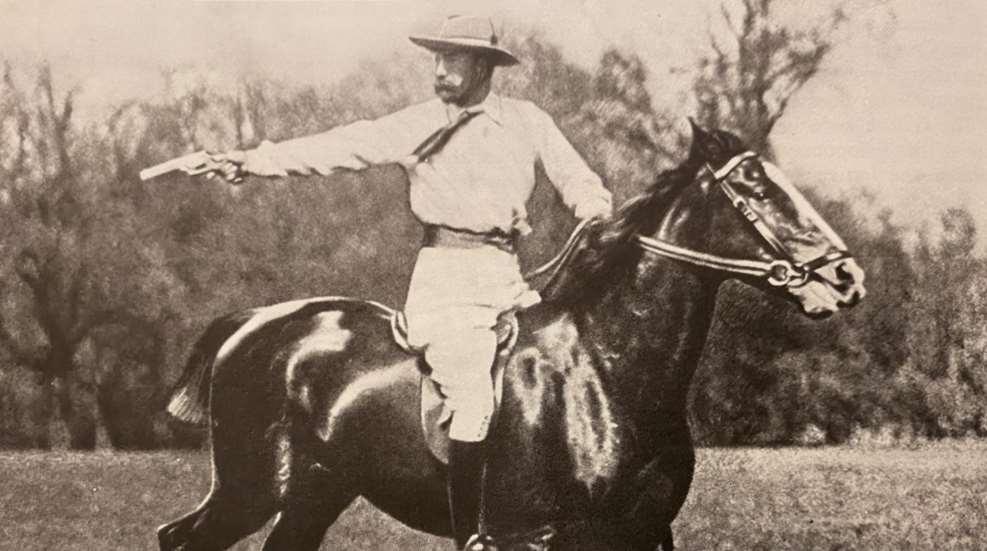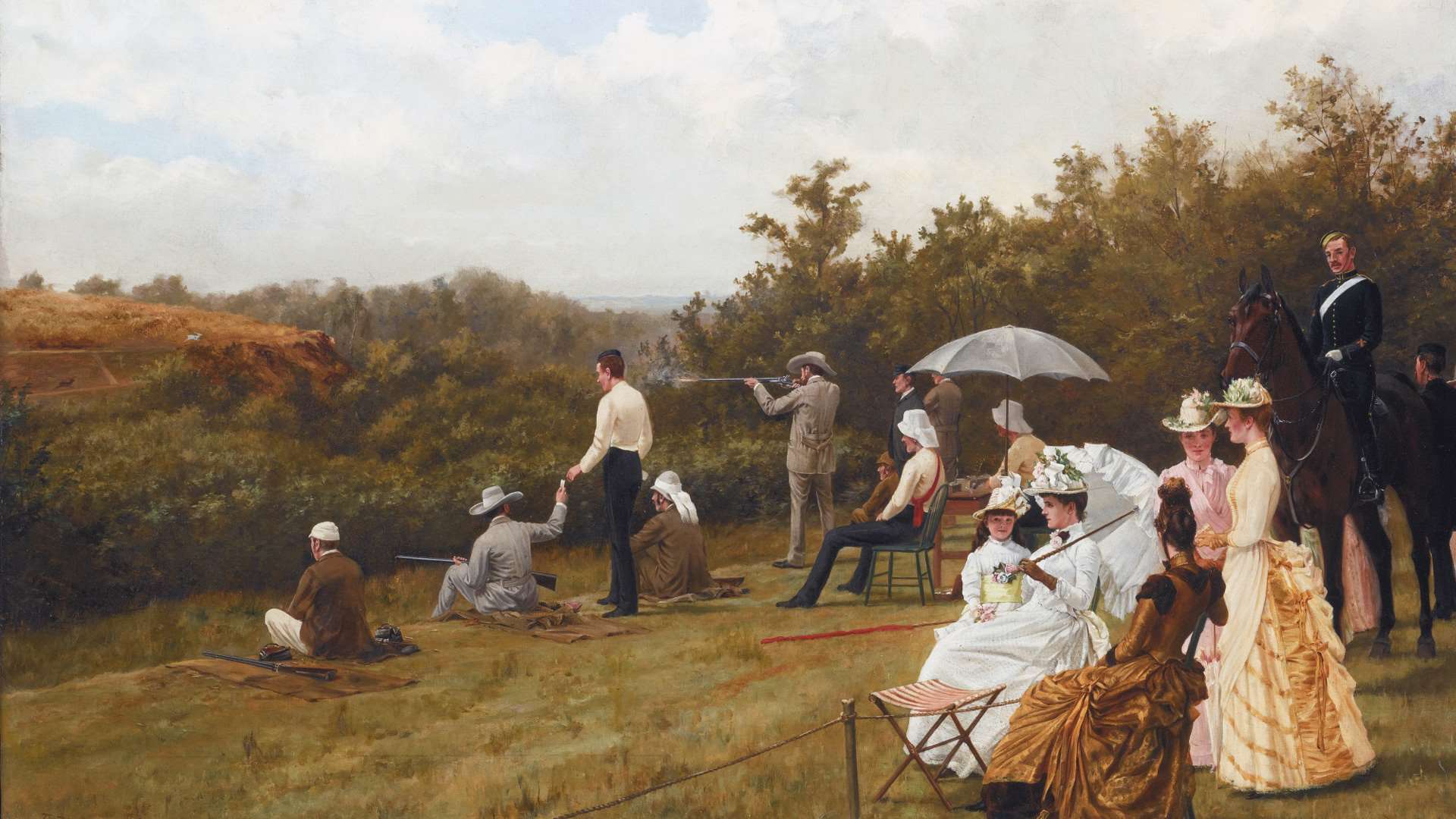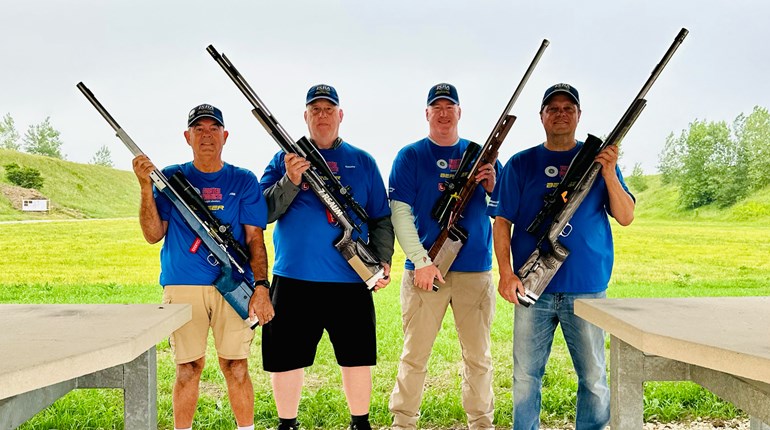
Running Target events were a part of Olympic shooting programs from 1900 until the last event that remained—10-meter Running Target—was eliminated after the Athens 2004 Games. (Women’s Double Trap was removed from the Olympic program at the same time.) The below is an excerpt about the early history of the Running Target event from the 1978 book, Olympic Shooting, written by Col. Jim Crossman and published by the NRA.
The Running Game Event
By Colonel Jim Crossman
The Olympic running game event through 1956 was shot on the running deer target at 100 meters. Later, the rules were amended to permit the use of the running boar or running roebuck target at 50 meters, and the event was made optional for the Games. A running game event was not included in the 1968 Olympics. Later the match was made a required event, and the running boar match was included from 1972 on.
The target used in the original match was deer-sized and marked off with scoring areas of value five to one. At 100 meters (110 yards) the deer runs across an opening of 23 meters (25 yards) in four seconds. Time is measured from the moment the deer’s tail clears the first barricade until his nose disappears behind the second barricade. From the moment the nose first appears until it disappears, the elapsed time is about 4.4 seconds. Average speed of the deer is about 12 miles an hour, but the speed is not uniform if the carriage is gravity-operated.
The deer runs first to the left and then to the right, and separate targets are used for each so that the animal is always facing in the direction he is moving. The deer runs from behind a high wall which conceals him to a low wall which permits his horns only to be seen for two or three seconds before he appears from behind the barricade. The target may be mounted on a trolley which is moved by a motor, or it may simply be pushed down an incline to run free across a level section and up an incline on the far side, with the track varying not more than 75 centimeters (30 inches) in height in the opening between the barricades.

The shooter must stand with the gun off his shoulder until the horns of the deer appear. He may use any hand-operated rifle of eight millimeters or less weighing not more than five kilograms (11 pounds) in weight and having a trigger pull of at least 500 grams (1.1 pounds). Either telescope or iron sights are permitted. The rifle may not be an autoloader.
There are two events shot on the deer: single shot and double shot. The single shot consists of 50 runs of the deer, in two series of 20 runs and one of 10 runs, one shot being fired at each run. The double shot event is fired in two series of 10 runs and one series of five runs, with the shooter firing two shots on each run. Once the match has been started, the deer stops at each end only long enough for the marking to take place, then runs again without command.
The running deer event is a precision match, calling for the rifle-shooting techniques of careful and precise aiming and good trigger control. These things must be done quickly and while the target is moving, but—make no mistake—the running deer match calls for precise shooting. Scores of about 45 per 10-shot string are required to win. To obtain 45, half of one’s shots must be in the six-inch five-ring at 110 yards, and the rest in the 12-inch four-ring.
A cartridge of low recoil is appropriate, especially in doubles. The bullet has no work to do other than to hit the target. If the bullet’s time of flight permits the use of a definite aiming point for lead, so much the better. The .222 Remington, with high accuracy and little recoil, turns out to be a good compromise. The necessary lead with the .222 is about two feet, which means the shooter can hold under the deer’s jaw, adjust the elevation as necessary, and have a distinct aiming mark.
In the running deer match shot at the IV Olympics 60 years ago, open sights were required. Later peep sights were permitted, and the most recent ruling allows telescope sights, although no Olympics have been shot under this ruling.
The rifle should be one that can be easily and quickly worked for the second shot in doubles and reloaded quickly while the target is being marked. The Remington slide-action Model 760 with a detachable box magazine is a popular choice.
The rifle should be stocked to fit the shooter well. When the deer’s horns first appear, the rifle should slide smoothly up into place on the shooter’s shoulder, while the stock comes up to meet his cheek with his eye looking down the sight. At the same time, the shooter swings along at the speed of the deer, with the sights down below his horns, so that when the deer appears free of the barricade, the shooter is looking at the aiming point and swinging the rifle at the same speed as the deer. It is then just a matter of making any necessary sight correction and squeezing off the shot. In doubles, the shooter works the action with the minimum possible disturbances, makes any slight aiming correction, and squeezes off another. Since the shooter uses the same aiming mark for all runs, he has only to worry about swinging smoothly, aligning the sights correctly, and squeezing the trigger correctly.
In the singles run, the shooter can be fairly leisurely about this if four seconds is considered leisurely. In doubles, where the shooter must do everything twice, as well as work the action, there is no time for dawdling. The shot must be gotten off as soon as it looks reasonably good; there is no time to make improvements.
Shooting the running deer event successfully requires that the shooter dry fire enough to work out carefully his technique for getting the gun into position with the least effort and to develop a smooth, steady swing. Releasing the trigger without disturbing swing or aim is also critical. Learning to work the action quickly with minimum disturbance to swing and sight picture may take some work. Practice in reloading the rifle while the target is being marked is necessary.
The running deer at 100 meters range uses up a rather large piece of real estate, so the running boar/running roebuck event was devised for more crowded conditions. The only difference between the boar and roebuck matches is the target. As in running deer, the target runs across an opening. The opening is only 10 meters (11 yards) across, however, and the range is only 50 meters (55 yards). The target runs across this opening in five seconds for the normal run, and there is nothing to warn the shooter the target is about to appear.
The shooter must stand with the stock of the rifle touching his hip until the target appears. The rifle is the same as for the running deer, except that it is limited currently to .22 caliber rimfire, although for some years both .22 rimfire and cartridges of the .222 Remington class were permitted.
There is one major difference in the two events, however, besides range and target size. In one of the running deer events, two shots were fired during a run. But in the running boar affair, only one shot is fired. However, the boar runs at two separate speeds, exposing himself for five seconds in the normal run, but only 2½ seconds in the fast run. This puts a premium on smooth, fast gun handling, sighting, and trigger control. With the boar running at two different speeds, two aiming points are needed to get the proper lead and good aiming points are rather hard to find.
The telescope sight is permitted and some shooters use a reticle with several marks in it to provide the proper lead for the various runs. While there is a little time for the shooter to improve his aim during the slow runs, in the 2½-second fast run the first sight picture must be used. And shooting is not for the whole hog, but only for that 2¼-inch 10-ring at 55 yards.
What sort of scores do you need? In the 1974 World Shooting Championships, the Columbian Bellingrodt established the 60-shot record on the new target with a 577. Second was also 577, while third was 572. The best U.S. score was 557, which points up the fact that there are few ranges and few shooters working at this game in the United States. Too bad, too!
While the 30-shot slow run and the 30-shot fast run in the usual program are tough enough, there is a 40-shot event known as mixed timing runs.
This is shot in two 20-shot series, each with 10 slow runs and 10 fast runs mixed up so the shooter does not know which is coming next. Consequently, he must be prepared for the fast run each time; if it turns out to be a slow run, he has time enough to recover. In Switzerland, this match was won with 385×400, thus with 15 or less shots of the 40 out of the little 10-ring.
In the slow run, the .22 Long Rifle cartridge calls for a lead of about 12 inches, which means holding out in the vicinity of the boar’s eye or front foot. The fast run at nine miles an hour, requires double this lead, or holding somewhere out on the target well ahead of the boar.
The same general principles apply to the running boar as to the running deer. but there are a few differences. The type of rifle can be different for the 55-yard event, since only single shots are fired. There is no necessity for practicing the quick operation of the rifle action during a run. But the total time, from the moment the shooter starts the gun up to his shoulder until the target disappears, is considerably less in the running boar event than it is in the running deer. There are five seconds in the normal run, where target time in the deer event is 4.4 seconds, plus a couple seconds warning when the horns appear. In the fast boar run, with only 2½ seconds to get the gun to his shoulder and a shot fired, the shooter does not have time for mistakes. Consequently, it is vital that the shooter get a gun stocked to fit him and that he practice and practice until it comes into place with the least effort and time, with his eye nicely lined up with the sights and the sights very close to the final point of aim and the rifle swinging at target speed.
It is too bad the running boar and running deer competitive sports are not more popular in the United States. They are fun to shoot and pleasant to watch, and they are great for improving field shooting. But there are only a few regulation running deer or boar ranges in the country.
For any shooter who would like to make an international team, there is less competition in this field than in most any other. Not that the competition is not tough—there is just not very much of it.
Editor's note: Pockets of Running Target devotees remain worldwide. Here is the link to a Nordic Shooting Region PDF rulebook for Running Target 100 meters dating from 2006 that is based on ISSF rules.


































